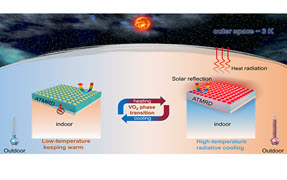Herschel Space Observatory to get Spectral and Photometric Imaging Receiver
The European Space Agency's Herschel Space Observatory, which will be launched in 2008, is a 3.5m diameter space telescope that will give access to the full 50-670μm wavelength range for the first time. The telescope will be passively cooled to about 80K by boiling off liquid helium in a cryostat that also provides cooling to the scientific instruments. This wavelength range is mostly inaccessible to ground observatories, due to absorption by the Earth's atmosphere. The Spectral and Photometric Imaging Receiver (SPIRE) is one of three instruments to fly on Herschel. SPIRE will take advantage of Herschel's capability by being the first instrument to survey the sky at the longer wavelength part of this range, complementing the Photodetector Array Camera and Spectrometer (PACS) instrument, which will be used for surveys at the shorter wavelengths. A third instrument, the Heterodyne Instrument for the Far-Infrared (HIFI), supports high-resolution spectroscopy.
SPIRE was built by a consortium of countries led by the UK and including Canada, China, France, Italy, Spain, Sweden, and the USA. It is designed to investigate the statistics and physics of early galaxy and large scale structure formation, which is seen at high redshift in the far-infrared and submillimeter ranges. SPIRE will also study the early stages of star formation. These scientific projects require large-area (tens of square degrees) deep imaging surveys, and follow up of these surveys with spectroscopy of selected sources.

SPIRE consists of two sub-instruments: a photometer and a spectrometer, which do not operate simultaneously. The photometer has a field of view (FOV) of 4×8 arcminutes on the sky observed simultaneously in three spectral bands at 250, 360 and 520μm. The detectors for both sub-instruments are arrays of feedhorn-coupled bolometers cooled to 300mK via an internal 3He sorption cooler. As the FOV is not fully covered by the detectors, sky coverage for mapping is achieved by scanning the telescope at an angle that guarantees a source will be seen by at least one of the pixels (scanning), or by moving the input from the telescope across the array with a steerable mirror in the instrument (jiggling). The other SPIRE sub-instrument is a Fourier-transform spectrometer (FTS) that provides adjustable spectral resolution (from 20-1000 at 250μm) covering a spectral range of 200-670μm. The spectrometer has a circular 2.6 arcminute FOV.
The flight model of SPIRE was delivered to ESA in March and is currently being integrated with the spacecraft and prepared for pre-launch spacecraft testing. Prior to delivery, the instrument underwent qualification testing including vibration, electromagnetic compatibility (EMC), and thermal testing. The flight model has also been through five performance test campaigns in a dedicated cryogenic test facility at the Rutherford Appleton Laboratory in the UK. The test cryostat, a liquid nitrogen vessel surrounding a pumped 4He vessel, provided the required 77K, 10K, 4.2K, and 1.7K temperature stages.
External radiation sources were coupled to SPIRE via a simulator of the Herschel telescope, situated on a low level optical bench next to the cryostat. A variable temperature hot blackbody source was used either directly as the telescope simulator input or as the input source to a test FTS, allowing spectral response measurements to be made. A line source was also provided via a tuneable Edinburgh Instruments far-infrared laser. In order to perform flat-field measurements on the arrays, a cryogenic cold blackbody source, variable from 4.2K to 40K, was situated in the cryostat. A flip mirror was used to switch between the internal blackbody source and the sources provided through the external telescope simulator. All tests indicate the instrument is behaving optically as predicted by the design, and the measured sensitivity is also in line with the design prediction.1
In March, following the successful conclusion of these tests at the instrument level, SPIRE was delivered to the Astrium premises in Friedrichshafen, Germany, where it was mounted onto the Herschel flight cryostat optical bench. It has since been joined by the other two Herschel instruments, PACS and HIFI. After undergoing tests at Friedrichshafen, the Herschel spacecraft will be moved to the ESA technical headquarters at the European Space Research and Technology Centre (ESTEC) in the Netherlands for further tests before being shipped to Kourou in French Guiana for launch in tandem with the Planck satellite on an Ariane 5 rocket in summer 2008.
Dr. Tanya Lim is the SPIRE calibration scientist responsible for the scientific test program and in-flight calibration. She is also responsible for scientific testing for the Mid-Infrared Instrument for the James Webb Space Telescope. Previously she has worked on the Infrared Space Observatory (ISO) Long Wavelength Spectrometer operations team, later becoming the UK ISO project manager.




